
Review
Battlefield 6 review: a return to old greatness
by Philipp Rüegg

In Pacific Drive, my car is the main character. I use it to explore a mysterious exclusion zone, falling more in love with my trusty station wagon with every kilometre and every threat.
Torrential rain lashes against the windows. The windshield wipers struggle in vain against the relentless downpour. My car’s warning system beeps and flashes like crazy. Lightning strikes my roof. The radiation has exceeded dangerous levels. Outside, the world is ending, but I hardly notice. My eyes are fixed on the horizon. There, an apocalyptic, glistening orange pillar of energy rises into the sky. It’s my way out of the Zone.
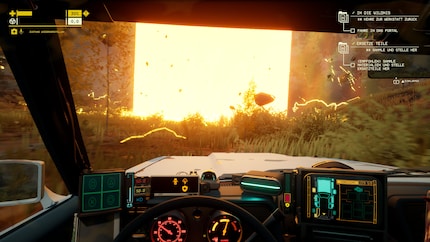
A glance at the speedometer says my tank is almost empty. But it’ll have to do. I put the pedal to the metal and race through the forest at breakneck speed. Just as I’m drifting down a slope, the battery indicator flashes too and my headlights go out. Damn. The bumper won’t handle many more collisions. I finally reach the end of the pitch-black forest. The energy column is right in front of me. I crash right into it, everything goes black… Moments later, I roll into my garage, relieved. My car and I groan and sigh collectively. We’ve successfully survived another trip into the Zone.
Pacific Drive is a survival game that largely consists of collecting resources, driving and fixing. I spend most of my time in the car. Before the pulse-pounding odyssey begins, the game developed by Ironwood starts with a leisurely jaunt through the forest. The radio plays chilled-out indie rock, the trees rustle in the wind. Suddenly, a huge portal sucks me in and spits me out again in the Olympic Exclusion Zone. The game doesn’t say who I am or what I’m doing here.
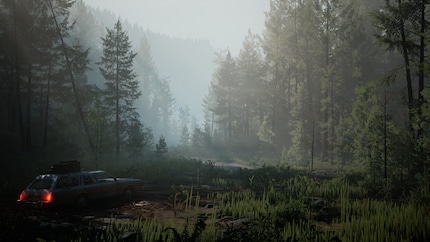
The Zone is a cordoned-off area, somewhere in the USA. Strange things are going on here, they say. The public never found out what exactly, the government has cordoned off a large area. The voices that greet me over the radio when I arrive obviously know better. They guide me to an abandoned garage, where the first thing I do is get my battered car road-safe again. Here, the actual game begins.
The story is told primarily via radio messages. 78-year-old Oppy, who owns the garage, as well as Tobias and Francis, two hobbyist Zone experts, regularly have their say. They lead me deeper and deeper into the Zone, explaining what it’s all about – when they’re not bickering. Apparently, something happened that turned the two parties into squabblers in the past. The voice acting is absolutely brilliant. From the very first minute, they sweep me away and paint a wondrous story about a misguided experiment. I also regularly find audio tapes by investigative journalist Chiaki, filling in the gaps regarding the events surrounding the Olympic Exclusion.
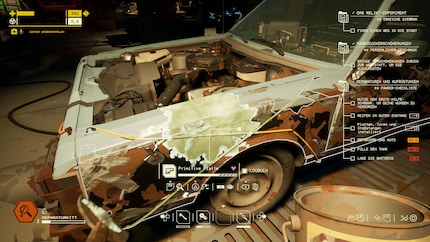
I start expeditions into the Zone from the garage. Outside, I gather resources and bring them back in one piece, hopefully alongside my car. Not an easy task whatsoever, given the conditions of the Zone. A lot of it reminds me of Chernobyl from the Stalker series. The weather is going crazy, there’s dangerous radiation everywhere and anomalies are the order of the day. These appear in a wide variety of forms. The Can Opener is a giant circular saw that runs along the floor. I’d rather my car didn’t come into contact with that. The Wriggling Wreck is a supposedly inconspicuous wrecked car. Only, the cylinders shoot out of the ground and energise the soil. You can probably imagine what happens with Bollards. These suddenly appearing rock formations block your way.
The Zone is divided into three parts. The closer I get to the centre, the worse the conditions and anomalies become. Especially at the start, my car and I are extremely susceptible to any kind of encounter.
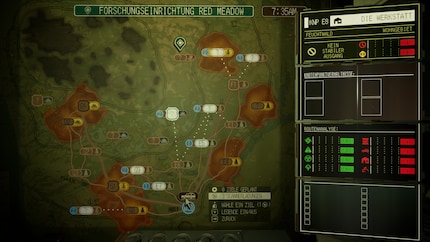
I do everything I can to keep my trusty station wagon, as they’re called in the USA, in good shape. After all, we’re a team. In Switzerland, these spacious vehicles are primarily known from older Hollywood movies. Fittingly, the game is set in 1998. Initially, the car is quite a rattletrap. But using resources from the Zone, I can not only equip the garage with new appliances, but also pimp my car. This is essential if I don’t want to change a tyre after every ride through the undergrowth.
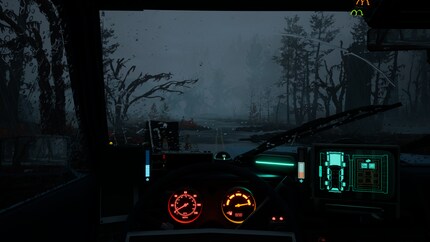
Pacific Drive plays almost like a simulator. Car parts are added and removed manually. I first build the additional floodlight on the roof at the workbench, then carry it to the vehicle. There, I mount it on the previously installed bracket. Same goes for the constant repairs. I patch cracks in the bodywork with a kind of superglue. The sealing kit gets punctured tyres back on the road, and the electrician’s kit allows the headlight to shine at full power again.
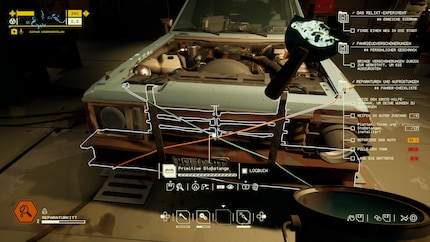
With increasing upgrades, my car looks more and more like the DeLorean from Back to the Future. I can also decorate my car. A glowing planet on the gearshift, a wiggling dog in a spacesuit on the dashboard or colourful foils for the bodywork, just to name a few. After a few hours, I feel more connected to my car than to any animal companion in any other game – with the possible exception of Roach from The Witcher 3.
To make improvements, I need the appropriate material and the corresponding blueprint. I activate it on the Fabrication Station. This also requires resources and energy. The latter, like everything else in the zone, can be found in so-called Stabilizers. They do exactly what their name suggests. If I remove an Anchor sphere, the Zone destabilises and negative anomalies increase. In the Zone, anchors are also used to open the portal that teleports me back to the garage. This opens up the supposed death ray mentioned at the beginning. At the same time, a circle rapidly forms that, as in any battle royale, should be avoided at all costs.
Pacific Drive contains an enormous number of vehicle upgrades and also a few for the driver, i.e. me. This includes things like a larger backpack or a Battery Jumper. It increases protection against electric shocks by 30 per cent. No idea what kind of magical thread it’s made of. The first thing I do with my car is swap summer tyres for more stable off-road tyres. The cladding receives an iron plate upgrade. I shield the hood so that it can absorb electric shocks. Frames for wind turbines and lightning conductors are added on the sides, and I pack a spare battery in the converted rear seat.
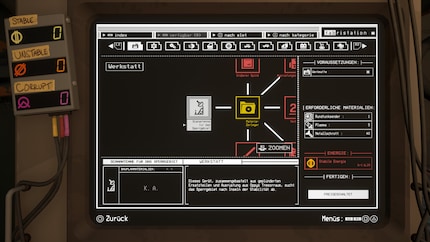
I’ve rarely experienced a game where upgrades are so satisfying. It’s the polar opposite of the incremental single-digit improvements in hit chance from Suicide Squad: Kill the Justice League. Every upgrade is useful and I want to unlock every single one, also because working on the car is so much fun.
Once my vehicle and I are ready for the Zone, I select my destination on a map. It all starts from the garage. Apart from a few highway shortcuts, I have to travel from junction to junction. I also can’t skip places I’ve already travelled to. I can see the status of a node on the map, whether a storm is currently raging there or how many resources are available.
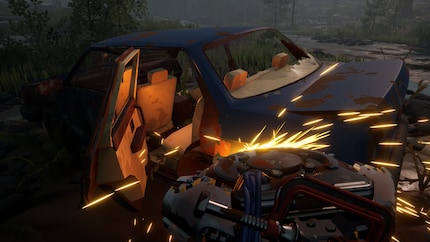
I find resources in buildings, which I sometimes have to break open with a crowbar, in crates, rucksacks or by scrapping vehicles and electronic devices. I use the, what else could it be called? Scrapper. It’s a kind of chainsaw that macerates car doors, tyres and headlights. I collect individual parts by hand or with what’s basically a vacuum cleaner. There’s a whole range of tools to salvage resources that, just like my vehicle, break down over time.
The central game loop sounds repetitive, but it motivates me again and again. Also because every ride feels exciting. I’m constantly afraid of pushing my luck too far.
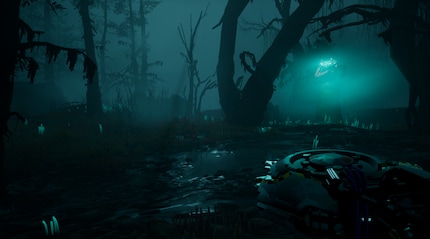
The driving itself is a far cry from fun racers like Forza Horizon. As with repairs, many individual steps are necessary. First, I press a button to open the driver-side door and get in, then I turn the ignition key and start the engine. I then select the gear stick and shift into gear. Headlights, windshield wipers, interior lights, radio – I control everything manually. I can even adjust the volume directly on the radio. Ingenious! Direct operation by looking at what you do is extremely needed. Almost every button on the controller is already assigned twice. At first, the controls are hopelessly overwhelming, just like the menu structure. After a few hours, they feel more and more familiar, just like the car.
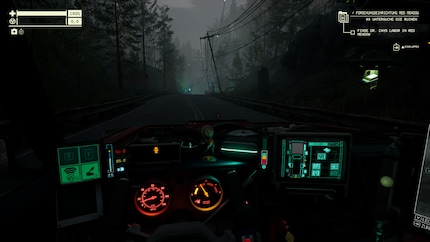
Nevertheless, I don’t race through the Zone like a madman. The roads are too damaged, anomalies are too frequent and the weather is unpredictable. I usually chug through the deserted landscape very carefully. I play on my PC with the PS5 Dualsense controller. While the adaptive triggers in most games get on my nerves after a few hours, they enhance the driving experience many times over in this game. Pressing the triggers hard makes the car feel just as unwieldy as I’d expect from a station wagon held together with tape and glue. And the subtle vibrations when something is wrong with my car or danger is approaching make an already nerve-wracking game even sweatier.
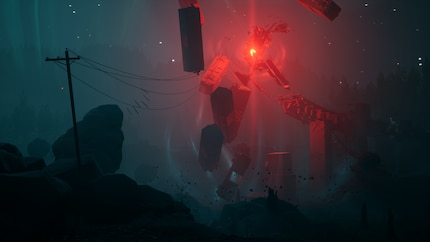
Pacific Drive may seem like a Sunday excursion simulator, but I constantly sense danger. And not just when it’s time to take the wheel and race to the rescue portal as fast as possible. Even if the weather isn’t crazy and I’m just driving from house to house in search of resources. I never know whether a drone is going to hijack my car or whether an unexpected breakdown will throw a spanner in the works. Wrong decisions can also quickly end a successful run. Should I get out and pump gas at an abandoned car and risk being caught by the circle of death? Or do I carry on driving and run the risk of the car dying at a crucial moment?
The constant restlessness stems from the unique atmosphere of the game, the Zone is full of mysterious buildings and machines. And there are Tourists everywhere. These anomalies look like frozen people, gruesome witnesses to the catastrophe. If I get too close, they’ll explode.
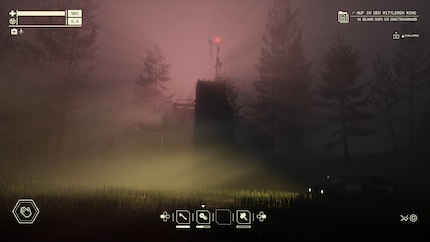
Thanks to Unreal Engine 4, Pacific Drive looks incredibly beautiful. Sometimes the sun’s rays shimmer dully through the trees and immerse the fog in a sea of red. Suddenly, a torrential downpour. Lightning strikes and I run to my comfortably warm car, whose headlights greet me from afar. The lighting effects are absolutely stunning. At times like these, I almost forget that the irradiated acid rain is corroding my car and me and that I should get out of here as quickly as possible.
The survival game Pacific Drive lives up to its genre description. If I, or rather my car, kick the bucket, I’m thankfully teleported back to the garage. But my car is almost ready for the scrap heap, and all my loot is lost – at least for the time being. As with a Soulslike, I can return to the place of my death and salvage resources from a burnt-out wreck.
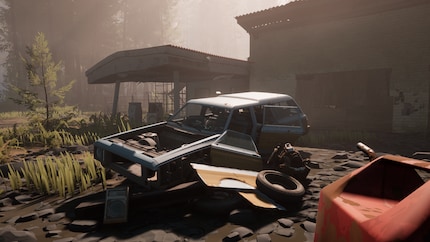
To prevent my beautiful upgrades from falling victim to the zone, I prepare myself as well as possible for my trips. This starts with car servicing, including refuelling, charging the battery and any necessary repairs. The vehicle also develops flaws over time. These can be harmless, such as the radio suddenly switching on. However, it can also be more problematic, such as when the steering wheel suddenly spins or the door bursts open. It’s best to document these defects in detail. This is the only way you can successfully use the Analyzer in the garage and find out how to rectify the faults. You have to select four states correctly before the device spits out the solution. Just be aware of what’s really a mistake and what’s by design. At one point I thought I’d completely deciphered a new error, only to realise that the gear that always kicks in automatically when I get in isn’t a fault, but the parking upgrade I installed.
Pacific Drive has become exactly the game I was hoping for. The Olympic Exclusion Zone is a mysterious restricted area that makes me curious to explore every nook and cranny. The story is captivatingly told by great narrators. Visually, Pacific Drive is a dream. I can’t get enough of the way the headlights on my trusty station wagon cut through the night.
The car is also the star of the game. From the pleasantly rough handling to the countless upgrades, all of which I install by hand, a real relationship develops. The many manual interactions are reminiscent of a simulator and are crucial to making the car feel alive. I love that I have to turn the ignition key when I start the car, or turn on the interior lights, or look towards the passenger seat to see the map.
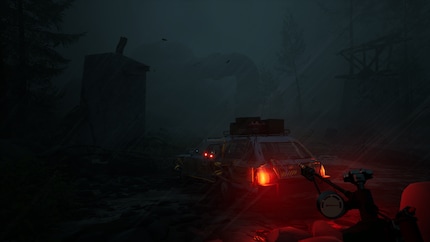
I’m even secretly happy about breakdowns, because then I get to make a new tool. Pacific Drive is a power fantasy for amateur mechanics. No matter how wrecked my car is, I can get it back on the road. And with every new figurine I can put on my dashboard or sticker adorning my trunk door, the car grows closer to my heart. I interpret the fact that it bangs me on the head from time to time as a clumsy proof of love. After all, that’s how I get it from my children.
The level of difficulty is also just right. The Zone is threatening, but the game is never unfair. When I do fail, there’s always a new wrecked car waiting in the garage ready to be scrapped, or a magic dustbin spitting out a few spare parts.
If I had to find fault with anything, it’d be that the radio stations need a larger selection of music. The soundtrack provides the perfect background music for lonely road trips, but after more than 20 hours, I can’t listen to some songs any more.
Otherwise, Pacific Drive is an unforgettable journey that you shouldn’t miss out on.
Pacific Drive will be available for PC and PS5 from 22 February. I tested the PC version, provided to me by Kepler Interactive.
As a child, I wasn't allowed to have any consoles. It was only with the arrival of the family's 486 PC that the magical world of gaming opened up to me. Today, I'm overcompensating accordingly. Only a lack of time and money prevents me from trying out every game there is and decorating my shelf with rare retro consoles.
Which films, shows, books, games or board games are genuinely great? Recommendations from our personal experience.
Show all